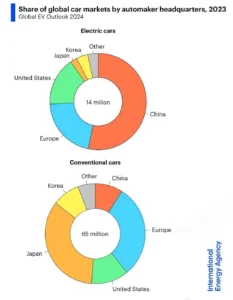The car market itself is a dynamic, global landscape where forces such as production capabilities and consumer demand are complexified by region-based rationales. The automotive market continues to be dominated by China, Europe and the US in 2023 although there were keep regional differences. Now we can take this another step by looking at the global car market share, and also how production aligns with sales in these key regions.

China: Dominating the Market
China continues to be the engine of global car sales with 53.9% share in total world passenger cars market. The big number underlines the huge volume of cars China buys on this growing middle class, plus urbanization and a burgeoning electric vehicle (EV) market fast taking shape.
Even under this dominance in sales, China accounts for only 9% of global car production. The gap shows that while China is the world’s biggest car market, some of those vehicles are made by foreign manufacturers from Europe, Japan and America. Economics of Scale : An EV push is also part of the more-than-aspirational ‘Make in India’ mandate and realisation that local automakers cannot develop opeImFundamental EC-Based Flarom scratch.
Europe: A Production Hub
Europe contains 21% of the global car market, hence it is ranked second in terms of region hold on high share. The healthy automotive industry in Europe, where prominent manufacturers like Volkswagen, BMW and Mercedes-Benz are based also fuels the growth in this region. Thus, the pull of demanding new unique models has combined with a push from ever-stricter environmental regulations making everyone want EVs.
Europe has been a main player in car production, accounting for nearly 30% of the global output; even with modest market share. Broadening from this high level of production capacity is two advanced manufacturing technologies, an extensive supplier base and a rich heritage in quality automotive parts provision. Europe is one of the world’s major exporting regions for automobiles and engineers have exploited these advantages, developing vehicles with a high level of precision engineering.
The United States: A Major Market with Moderate Production
The US is still the world’s second-biggest car market, accounting for 16% of global sales. American consumers have always had a soft spot for vehicles, especially big trucks and SUVs, which helps contribute to this market share. General Motors, Ford and Tesla are Canadian — not to mention domestic powerhouses on the world stage.
The U.S. is responsible for 12% of global production, that the US isn’t responsible for quite a massive number–though it is still a big chunk of consumption, or just shy of its 15 to 20 percent market share. By no means is this the case with all electric vehicles and only a handful of luxury brands that see increasing interest among American buyers.
Japan: A Small Market, A Production Giant
The third biggest auto market in the world (though only contributing 2% to global car sales) is still a heavyweight when it comes to making cars. Japan contributes 35% of the world’s production share and is a major influence on global automotive industry exports
This number is indicative of the world-class manufacturing efficiency and tech that Japan has developed over the last few decades, along with its well-known brands like Toyota, Honda and Nissan. The country’s continued emphasis on both traditional internal combustion vehicles and electric cars keeps it part of the global auto conversation despite its dwindling domestic demand.
South Korea: A Balanced Player
South Korea accounts for 4 percent of the worldwide automobile market and contributes to some 9% in auto production. Home to respected global brands like Hyundai and Kia, South Korea has made its presence known in the world automotive market. This quality and affordability has seen the country retain a healthy market share as well as steady production.
Meanwhile South Korea is also increasing its footprints in the EV segment with investments towards electric mobility & battery technology. Maintaining this market share-production tension is what keeps south Korea competitive in the global automotive world.
Rest of World: Lesser But Not Insignificant Role
The remaining 3% of the global car market and around five percent of world output is made up by other countries. With the exception of the EU/EFTA region, others like Africa, Southeast Asia and South America account for only a small sliver of global output. But with these regions burgeoning in the coming years and demand for cars expected to soar, their share of production — as well market share is likely to rise significantly.
Conclusion
Key manufacturers make up the majority of car market globally with China ahead in terms of production, and both Japan as well Europe leading segments specific producers. On the one hand, car production and market share are in balance in markets such as the U.S. or South Korea; on the other there is a lack of relevance to consumption outpacing output greatly–markedly influenced by China (faster growth rate than any plant systematic actions) and Japan (range reduction vs part required).
Source: Avocets Consulting As the industry transitions into a new era of electric vehicles, and as consumer tastes continue to change in mature markets like North America & European Union (EU) [1] we can expect both global automotive production volumes and per region market share will witness significant shifts over the next 5 years
